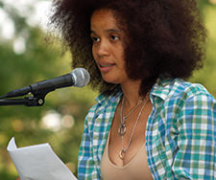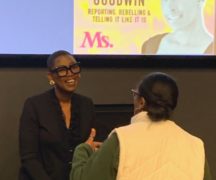By DAVID DUPONT
BG Independent News
Scholar Pirkko Markula’s talk Monday at Bowling Green State University on “Women’s Empowerment Through Sport and Exercise: Rhetoric or Reality?” revolved around pole dancing, or pole fitness, as it has come to be called.
The exercise, popularized in strip clubs, has become a popular form of fitness training for women.
Markula opened her talk with positive comments about the activity by one of her students and testimonials from those who participate in pole workouts. The student reported that it helped build her self-confidence as someone who had “overwhelming dissatisfaction with my own body.”
This led Markula, who is a professor at the University of Alberta, to wonder: “Pole fitness may be an avenue by which women can develop and maintain positive body image as a result of an environment that emphasizes body acceptance and the body’s abilities.”
Still the exercise, with its emphasis on shaping the woman’s body in a stereotypical form that appeals to men, is problematic.
At the conclusion of the lecture, Leda Hayes, a graduate student in American Culture Studies, asked the speaker if the popularity of pole fitness could lessen the stigma on those working in the sex industry.
Markula said she, contrary to what some believe, considers the sex industry harmful to women, and she wondered why women would choose the particular form of exercise to do. There are other forms of pole exercise, including one practiced in China, that are not sexualized and provide the same benefits.
Pole fitness, like female sports and fitness in general, is fraught with issues about social expectations and norms, about empowerment and submission to social stereotypes. Pole fitness “reflects the multi-meanings of feminism for today’s active women,” she said.
In her talk, Markula explored the theoretical responses to sports and fitness.
Liberal feminists, she said, advocate for inclusion in sports. “Women are liberated when barriers are lifted.” They advocated for Title IX that opened up participation of women in school sports. They pushed for greater inclusion of women in the Olympics. Nearly half the athletes at the last Olympics were women. However less than 3 percent of the media coverage was about women.
“Equality,” Markula said, “has not been achieved.”
Critical feminists, Markula said, contend that liberal feminism fails because it does not challenge the underlying structure. Women may be tennis players, swimmers, soccer players, boxers or weight lifters, but the media coverage still emphasizes their personal lives, their mates and how they deal with motherhood, not their athletic accomplishments.
And the emphasis remains on those who are white and middle class and possess “the thin, toned sexy femininity attractive to men” as opposed doing those with more muscular physiques.
Liberal feminists, Markula said, were accused of doing too little to challenge the social structures “that keep male dominance in place.”
Post-feminism “actively works to undo feminism while simultaneously appearing to be involved in a well-informed and well-intentioned response to it,” Markula said. “It’s a sensibility that combines feminist and anti-feminists themes.”
From feminists, post-feminists adopt the language of empowerment. Yet the empowerment is tied to the notion that being fit is to conform the same “hetero-normative” body image. One fitness magazine promises not just a sexy body but “a body built for sex.” Women are challenged to actively participate in their own objectification.
It places, Markula said, “continued emphasis on the sexy body that is at the same time a source of power but also an unruly, out-of-control body that requires constant work and self-monitoring to conform to the ever-narrowing judgments of female attractiveness.”
One of the newer trends in fitness is barre workouts, based on ballet exercises. The promotion, eerily similar to that for pole fitness, still emphasizes the traditional lithe female form. The exercises shown online, she said, develop a woman’s muscles, but it is lean muscle.
Markula is currently studying this style of exercise, and teaches it. Rather than focusing on losing weight and toning muscles, Markula said, “I based my class design on functionality.”
“How can we move better in everyday life? And how can dance-inspired movement improve the awareness of our bodies?”
She said: “As a researcher and practitioner, I also need to rethink what it means to be a feminist.”





